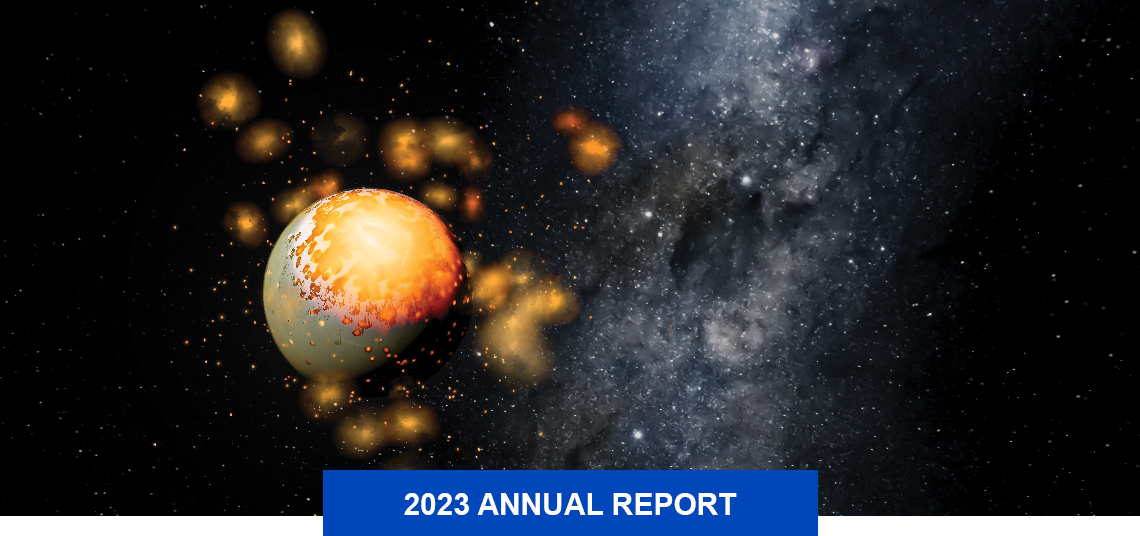
About the Header
An SwRI-led team compared the early impact history of Venus and Earth, determining that Venus experienced higher-energy impacts creating a superheated core. Models show these conditions could have created Venus’ extended volcanism and younger surface.
Southwest Research Institute is home to one of the nation’s leading space science and engineering programs, conducting fundamental and applied research and developing innovative technology for commercial companies and government agencies worldwide. In 2023, SwRI reorganized its space science program and added a new building to support tremendous growth in the small satellite and commercial spaceflight arenas. The Institute’s strong Earth science expertise complements our space research.
In addition to investigating space phenomena and developing payload instruments, electronics and spacecraft, SwRI scientists are leading five space missions. The Juno mission continues to explore Jupiter and its moons, while New Horizons proceeds through the Kuiper Belt, exploring the edge of our solar system. The four Magnetospheric Multiscale (MMS) spacecraft continue studying magnetic reconnection in the Earth’s magnetosphere. And the Polarimeter to UNify the Corona and Heliosphere (PUNCH) mission, which will explore connections between the solar corona and solar wind, made major progress in 2023, integrating and testing four spacecraft and five instruments in preparation for a 2025 launch.
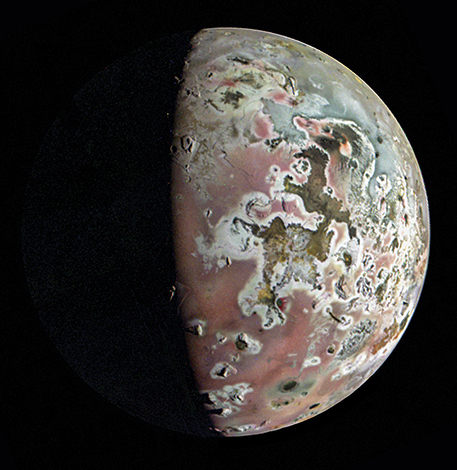
Courtesy of NASA/JPL-Caltech/SwRI/MSSS/Björn Jónsson © CC NC SA
During Juno’s extended mission, the NASA spacecraft flew past Jupiter’s volcanic moon Io, capturing JunoCam images from a distance of only 7,260 miles. JunoCam images are processed by citizen scientists around the world.
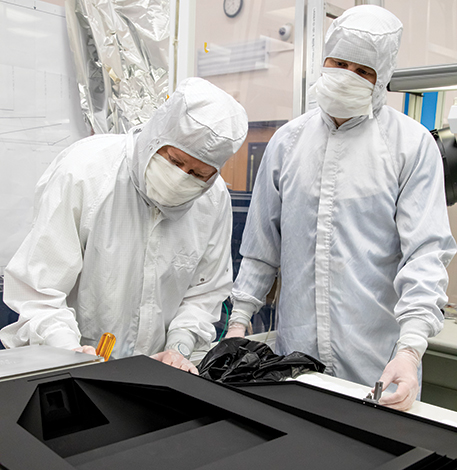
In 2023, SwRI integrated and tested three Wide Field Imagers for the PUNCH mission, which will study the inception of the solar wind.
The Lucy mission to Jupiter’s Trojan asteroids added a new flyby target in early 2023, a small main-belt asteroid now named Dinkinesh, to test drive the spacecraft’s novel terminal tracking system. Designed to keep tabs on a target as the spacecraft flies past at 10,000 miles per hour, the system performed flawlessly, and the Lucy team discovered that Dinkinesh was not just two objects, the main asteroid and a moonlet, as first imaged, but that the moonlet itself is a contact binary — two smaller objects touching each other. Over Lucy’s 12-year mission, the spacecraft will observe eight target asteroids with three known satellites, including the newly discovered moonlet now named Selam.
In 2023, NASA selected SwRI to lead the Center for Lunar Origin and Evolution (CLOE), which will conduct basic research to support science enabled by human exploration of the Moon as well as the Endurance-A mission concept, a far-side lunar rover mission. SwRI will also lead a NASA/NOAA lunar lander/rover instrument suite, Dating an Irregular Mare Patch with a Lunar Explorer, or DIMPLE, designed to expand our understanding of the Moon’s volcanic history. DIMPLE will use cameras and radioisotope-based dating to determine the age and composition of an anomalously young-looking patch of basalt named Ina. It will use the first-ever, purpose-built radioisotope-rock-dating instrument for use in space, called CODEX (Chemistry Organic and Dating Experiment), which was initially developed using SwRI internal funding.
In 2023, SwRI delivered three instruments for spacecraft integration, including the Mass Spectrometer for Planetary Exploration (MASPEX) instrument for NASA’s Europa Clipper spacecraft. Along with SwRI’s Ultraviolet Spectrograph (UVS) delivered in 2022, MASPEX will investigate gases around the Jupiter moon and its potential habitability. The Lunar Magnetotelluric Sounder (LMS) is being integrated into a lunar lander scheduled to arrive at the Moon in 2024 to measure the electrical conductivity of its subsurface. SwRI also delivered the Magnetic Anomaly Plasma Spectrometer (MAPS) for NASA’s Lunar Vertex mission to study how the solar wind interacts with the Moon’s surface materials in anomalous regions of magnetic rocks.
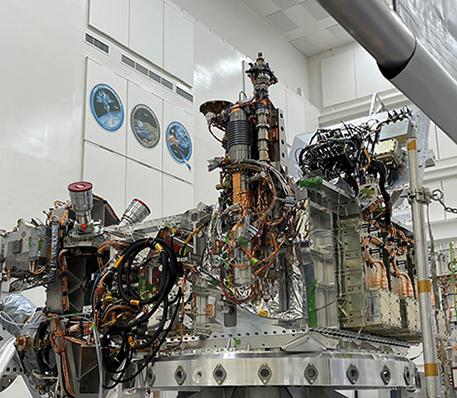
SwRI delivered the innovative MASPEX instrument for integration and functional testing on the Europa Clipper spacecraft. MASPEX has a mass resolution hundreds of times finer than anything that has flown to space before.
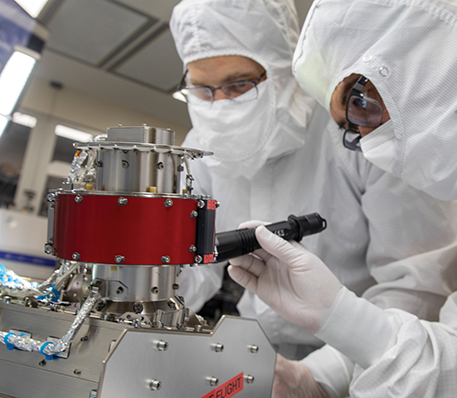
Courtesy of SwRI/UNH
From aboard the Lunar Vertex lander, the Magnetic Anomaly Plasma Spectrometer (MAPS) will study the interaction of the solar wind with surface materials on the Moon, particularly lunar swirls that correspond with anomalous regions of magnetic rocks.
SwRI continues its work on NASA’s Interstellar Mapping and Acceleration Probe (IMAP) mission, which completed its critical design review in 2023, managing its payload office, providing the scientific instrument Compact Dual Ion Composition Experiment (CoDICE), and participating on other instrument teams for the mission. IMAP will study the interaction between the solar wind and the interstellar medium as well as the fundamental processes of particle acceleration in space.
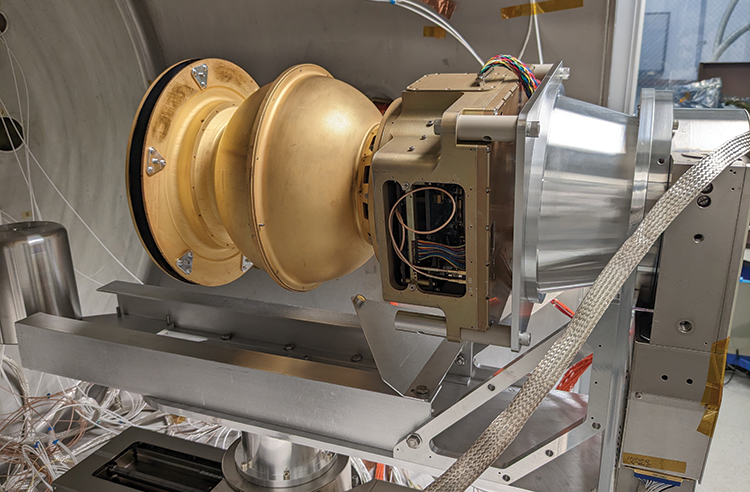
SwRI is providing the CoDICE instrument for the IMAP mission. CoDICE combines the capabilities of multiple instruments into one patented sensor to measure the distribution and composition of interstellar particles entering our solar system.
SwRI’s Solar Wind Plasma Sensor (SWiPS) for a NASA/ NOAA space weather satellite mission is built and undergoing evaluation. SWiPS will measure the properties of solar wind ions, including the very fast ions associated with coronal mass ejections that interact with the Earth’s magnetic environment. The Institute is also developing a cost-effective, high-resolution space-based infrared imaging system, Pleaides, that can be optimized to map wildfires or detect methane pipeline leaks in real time. Designed for SmallSat constellation deployment, Pleaides uses machine-learning-based algorithms to rapidly and autonomously process, detect and map data.
NASA and NOAA selected SwRI to develop QuickSounder, the first project in NOAA’s Near Earth Orbit Network. For this pathfinder mission, SwRI will develop the spacecraft, integrate NOAA’s Advanced Technology Microwave Sounder Engineering unit, qualify the observatory, deliver for launch and operate the mission for three years. QuickSounder will support NOAA’s next-generation satellite architecture development for its future low-Earth orbit program, providing weather forecasting, climate monitoring and environmental observation for years to come.
While the number of satellites in low Earth orbit (LEO) is increasing exponentially, potentially destructive LEO objects less than 4 mm in size cannot be detected using current technology. SwRI has developed a unique micrometeoroid and orbital debris (MMOD) detector to identify the location and size of small objects as well as their impact velocity, angle and nature by analyzing impact-generated strain waves between a pair of additively manufactured aluminum plates. This detector can be mounted on a spacecraft to understand the MMOD environment at various orbits.
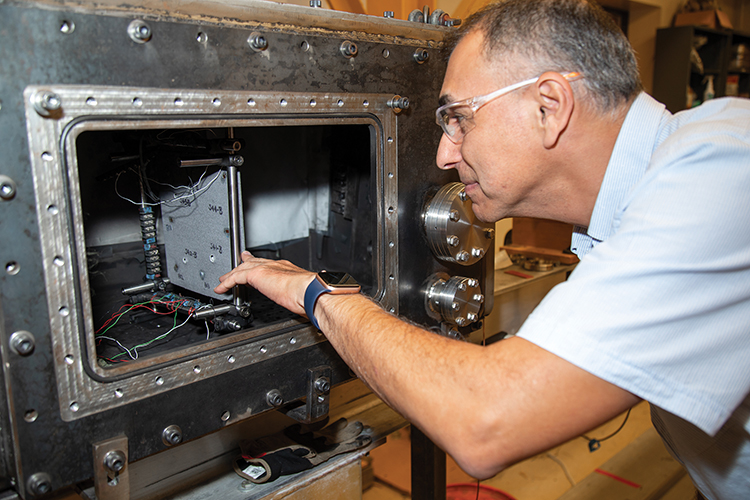
SwRI developed a micrometeoroid and orbital debris (MMOD) detector to find potentially dangerous small objects in low Earth orbit (LEO), addressing challenges associated with increasing numbers of LEO satellites.
SwRI heliophysicists took on several new, exciting projects in 2023. Institute scientists will create unique data of the April 8, 2024, solar eclipse through two groundbreaking, simultaneous projects. Scientists will image the solar corona in infrared light from NASA’s high-flying WB-57 scientific aircraft and in polarized white light from a series of 35 separate observing stations spaced along the path of totality through the Citizen Continental-America Telescopic Eclipse 2024 project. The Southwest Solar Coronagraph (SwSCOR) effort, initially developed with internal funding, also won a Phase A contract, a definition-phase study to develop the next generation of operational instruments to forecast space weather with live images of the Sun’s corona and solar events.
SwRI is leading two “Precursor Science Investigations for Europa” teams to understand critical topics in advance of NASA’s Europa Clipper mission to the Jupiter moon. Both projects are investigating the connection between Europa’s icy surface and its subsurface, which is thought to contain a potentially habitable ocean. One project will specifically track 3D ice shell evolution and material exchange between the surface and subsurface to predict the features likely to provide the best information and context for interpreting Clipper data. The second project will identify compositional signatures of subsurface environments, track how they evolve due to transport processes and then use machine learning to process related laboratory data from the MASPEX engineering model.
SwRI is collaborating with the University of Western Sydney and the International Centre for Neuromorphic Systems to investigate new sensor technology for space applications. These sensors would emulate the functionality of the human brain, greatly reducing the processing required and data generated for space applications ranging from docking to Earth observation and astrophysics research.
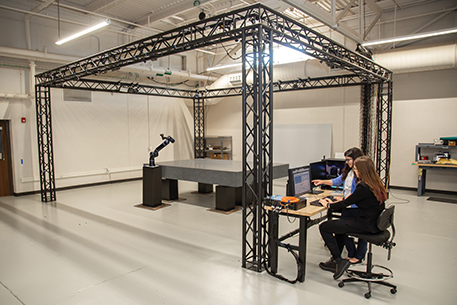
To simulate microgravity, a new space robotics facility will conduct nearly frictionless planar motion testing using a collaborative robot and a large granite slab.
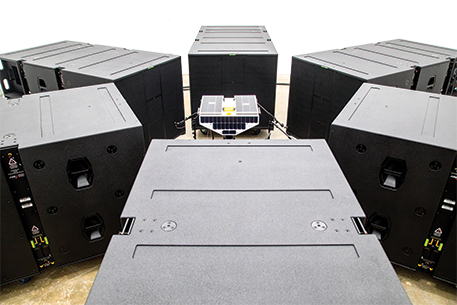
SwRI evaluates space systems, such as SmallSats, in a new aerospace acoustic test chamber outfitted with six speakers that can collectively produce up to 150 decibels, simulating the harsh, complex acoustic environments associated with rocket launches.
SwRI scientists are researching additively manufactured microchannel plates to detect signals from electrons, ions, x-rays and gamma rays. Using additive manufacturing to create microchannel plates can improve collection efficiency, amplification control and thermal resistance, which could lead to a new generation of space science and Earth observation instruments.
Using internal research funding, staff conducted field work in the high arctic region of Canada to develop techniques to understand the microbiology of subterranean icy environments to ultimately drive developments for future missions in search of life, including in the Martian subsurface.
SwRI is developing new software and testing tools to support the emerging field of space robotics. The Maturing Adaptable Space Technologies project is developing software that models robotic motion in the challenging environment of space. To simulate microgravity, the new Space Robotics Center will conduct nearly frictionless planar motion testing using a robotic arm and a granite slab. Surrounding trusses use motion capture cameras and lighting to support video analysis of the motion data.
In another effort, we adapted source code from the SwRI-developed Cyclone Global Navigation Satellite System (CYGNSS) spacecraft to reduce the time and associated costs needed to develop, test and demonstrate flight software.
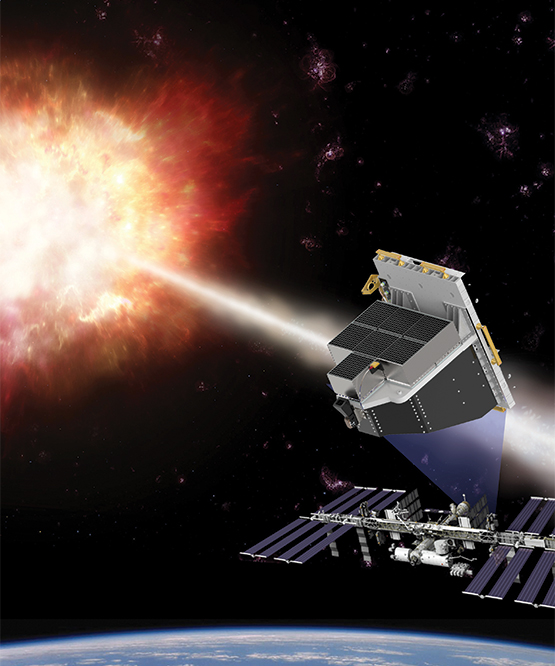
Courtesy of SwRI/UNH
In 2023, NASA conducted a site visit for the LargE Area burst Polarimeter (LEAP) instrument project. Designed to attach to the International Space Station, LEAP will study distant energetic events, such as the birth of black holes and death of massive stars.
